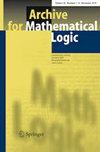广义度量结构中的平稳性
IF 0.3
4区 数学
Q1 Arts and Humanities
引用次数: 1
摘要
我们从几个基本方面扩展了度量抽象初等类(maec)的框架,主要是通过允许度量在一个行为良好的量子化中取值。作为概念证明,我们表明Boney和Zambrano(围绕度量抽象初等类的d-驯服的集合理论一致性,arXiv:1508.05529, 2015)关于大基数假设下(度量)驯服的结果在这种更一般的背景下成立。我们简要地考虑了对偏度量空间的进一步推广,并暗示了与模糊结构类和轴上结构的联系。本文章由计算机程序翻译,如有差异,请以英文原文为准。
Tameness in generalized metric structures
We broaden the framework of metric abstract elementary classes (mAECs) in several essential ways, chiefly by allowing the metric to take values in a well-behaved quantale. As a proof of concept we show that the result of Boney and Zambrano (Around the set-theoretical consistency of d-tameness of metric abstract elementary classes, arXiv:1508.05529, 2015) on (metric) tameness under a large cardinal assumption holds in this more general context. We briefly consider a further generalization to partial metric spaces, and hint at connections to classes of fuzzy structures, and structures on sheaves.
求助全文
通过发布文献求助,成功后即可免费获取论文全文。
去求助
来源期刊

Archive for Mathematical Logic
MATHEMATICS-LOGIC
CiteScore
0.80
自引率
0.00%
发文量
45
审稿时长
6-12 weeks
期刊介绍:
The journal publishes research papers and occasionally surveys or expositions on mathematical logic. Contributions are also welcomed from other related areas, such as theoretical computer science or philosophy, as long as the methods of mathematical logic play a significant role. The journal therefore addresses logicians and mathematicians, computer scientists, and philosophers who are interested in the applications of mathematical logic in their own field, as well as its interactions with other areas of research.
 求助内容:
求助内容: 应助结果提醒方式:
应助结果提醒方式:


